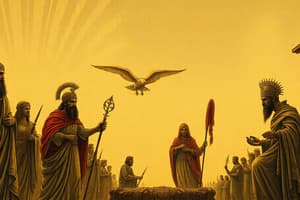Podcast
Questions and Answers
Enslaved people in ancient Rome were priced based on their abilities, with skilled individuals costing more than those without skills
Enslaved people in ancient Rome were priced based on their abilities, with skilled individuals costing more than those without skills
True (A)
The act of freeing an enslaved person in ancient Rome was known by the term, 'manumission
The act of freeing an enslaved person in ancient Rome was known by the term, 'manumission
True (A)
Freedmen and freedwomen had the right to vote and participate in Roman politics.
Freedmen and freedwomen had the right to vote and participate in Roman politics.
False (B)
The Retiarus gladiator was named after a type of wall in ancient Rome and was known for their very heavy armour and strong shield.
The Retiarus gladiator was named after a type of wall in ancient Rome and was known for their very heavy armour and strong shield.
The Thracian gladiator was armed with a trident and a net.
The Thracian gladiator was armed with a trident and a net.
Gladiator training was inexpensive and was often a hobby of many Roman citizens.
Gladiator training was inexpensive and was often a hobby of many Roman citizens.
Gladiators were very well-respected in Roman society and often became influential politicians.
Gladiators were very well-respected in Roman society and often became influential politicians.
The Samnite gladiator was named after an ancient Greek civilization and was armed with a curved sword known as a scutum.
The Samnite gladiator was named after an ancient Greek civilization and was armed with a curved sword known as a scutum.
Flashcards
What determined the price of an enslaved person?
What determined the price of an enslaved person?
The price of an enslaved person in ancient Rome depended on their skills and talents. Skilled individuals, like cooks, were more expensive than those without valuable skills.
What roles did enslaved people fill in ancient Rome?
What roles did enslaved people fill in ancient Rome?
Enslaved people in ancient Rome could perform a wide range of roles, from cooking and cleaning to serving as soldiers, builders, and even doctors.
What is 'manumission'?
What is 'manumission'?
The process of freeing an enslaved person in ancient Rome was called manumission. This could be achieved through self-purchase or by being granted freedom by their enslaver after many years of service.
What limitations did freed slaves face?
What limitations did freed slaves face?
Signup and view all the flashcards
What were gladiators?
What were gladiators?
Signup and view all the flashcards
What was involved in training to become a gladiator?
What was involved in training to become a gladiator?
Signup and view all the flashcards
How did politicians use gladiatorial shows for their own benefit?
How did politicians use gladiatorial shows for their own benefit?
Signup and view all the flashcards
What were the potential rewards and dangers of becoming a gladiator?
What were the potential rewards and dangers of becoming a gladiator?
Signup and view all the flashcards
Study Notes
Roman Slavery
- Enslaved people were bought and sold in markets, with prices determined by skills.
- Skilled slaves (e.g., cooks) were more expensive than unskilled ones.
- Age also influenced price, with younger, stronger slaves commanding higher prices.
- Skills were important for better treatment from their owners.
- Slaves worked in various roles, including cooks, soldiers, messengers, cleaners, builders, servants, accountants, gladiators, farmers, and doctors.
Manumission
- Manumission was the act of freeing an enslaved person.
- Enslaved people could buy their freedom or be freed by their owners.
- Freed slaves were called "freedmen" or "freedwomen."
- Even when freed, former slaves couldn't participate in politics.
Gladiators
- Some slaves became gladiators, a form of entertainment
- Gladiator training was expensive.
- It was also a way to entertain the people
- Gladiators were often prisoners of war or voluntary recruits.
- Some citizens could also become gladiators.
- Being a gladiator could make you rich and famous but was dangerous.
- Types of gladiators included Thracians (curved sword and shield), Samnites (sword and shield), Murmillos (sword and shield), and Retiarii (trident and net).
Studying That Suits You
Use AI to generate personalized quizzes and flashcards to suit your learning preferences.




